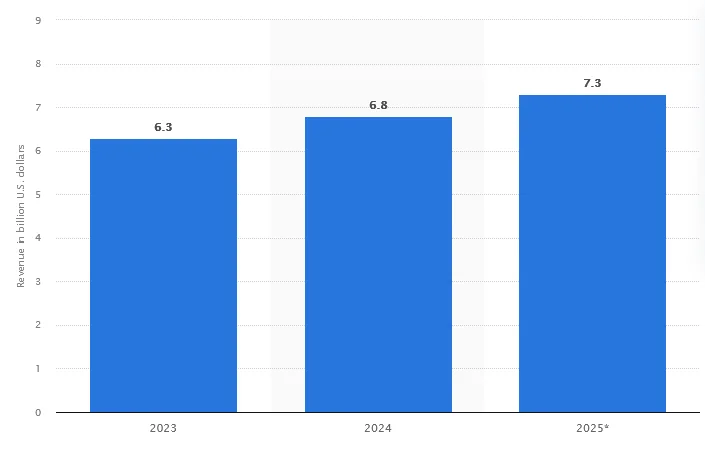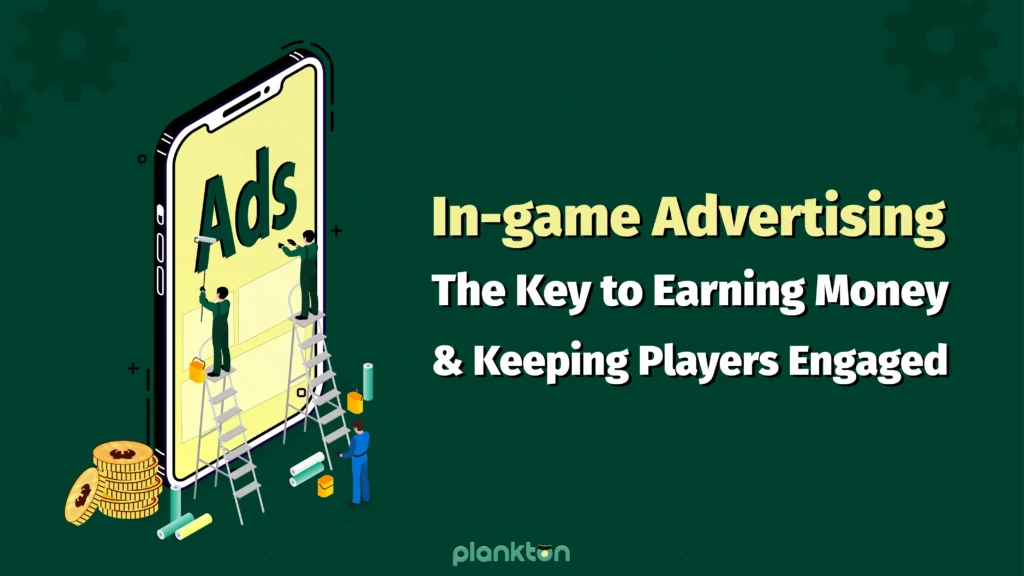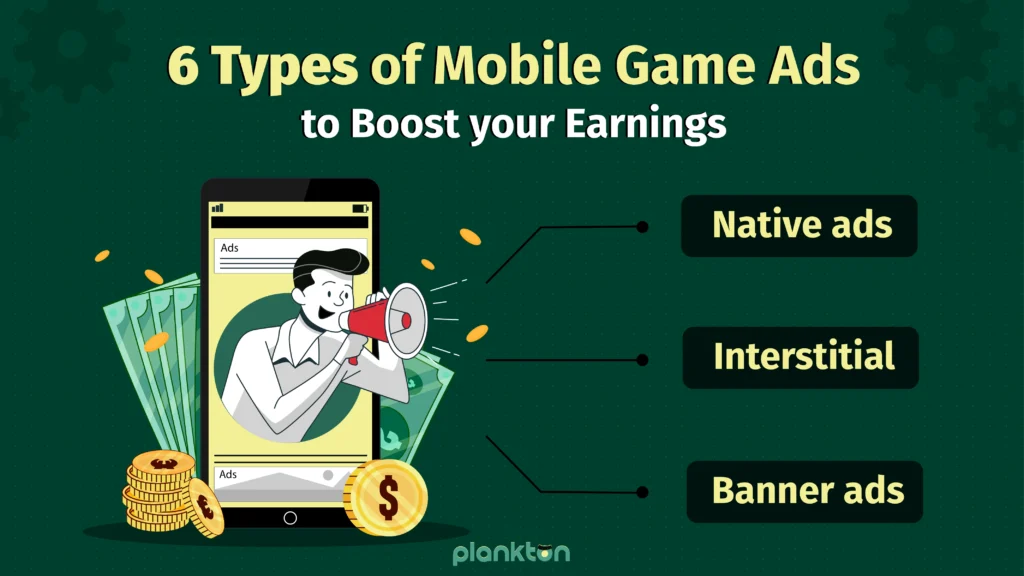With Statista forecasting the global mobile games market to soar to approximately $126.06 billion by 2025, it’s clear that in-game advertisement is shaping the mobile gaming landscape.
For new game developers, publishing your game for free and monetizing through in-app ads and in-app purchases is a smart way to capture a larger audience and boost your revenue.
In this post, you’ll discover the in-game advertising definition, how it works, and the benefits it offers. Later on, I’ll walk you through the various ad formats and share proven strategies to succeed in your monetization journey.
What is In-Game Advertising in Mobile Games?
In-game advertising is a revenue strategy for mobile games that helps creators make money from their game apps. There are various strategies and formats for placing ads in mobile games. We’ll explore these in more detail in the following sections.
According to IronSource (an app monetization company), the best ads are the ones implemented directly into the game. I mean, they look like a part of the game, contributing to a better game experience that results in higher engagement and retention rates.
How Does In-Game Advertising Work?
This is how games make money from ads: there are two parties involved in advertising in mobile games: advertisers and developers. Developers plan and design different ad spaces in their games and sell them to marketers. On the other side, advertisers pay to show ads in these places to promote their products or services.
As most mobile games come with a free-to-play model, showing in-app ads to users is one of the common ways to monetize your gaming app. Although players do not welcome ads, most are OK with them if they are used properly without ruining the gameplay.
How Do Games Serve In-Game Ads?
It’s done through a service called the ad network. An ad network facilitates this process by acting as a mediator. Your mobile game sends a request to the ad network, and the service decides, based on data, to show the ads to the user. After the ad is served, the developer receives a fee.
You can integrate these ads into your game mechanics or show them separately, like a banner.
Keep reading this article to find out about the different methods of serving ads to players.
In-game mobile ads come in various formats, such as image, video, or even audio.However, they all have one thing in common: they aim to gain attention from potential users without disrupting the game experience.

As you can see in the chart above, revenue from mobile game advertising has been growing in recent years and can reach more than $7 billion. It’s clear that marketers use this medium to reach their target audience.
Therefore, it’s a good strategy to use the opportunity to earn a profit for your mobile game, use the money to reach new players and work on new projects.
The Benefits of Mobile In-game Advertising
In-game advertising has various advantages. Mobile games offer a safe place for advertisers to introduce their products or services.
Why is it safe?
In the mobile gaming world, filters prevent the display of inappropriate user-generated content. This protects the brand’s reputation, increases user trust, and makes advertisers more willing to invest in in-game advertising.
On the other hand, various formats of mobile game ads, like rewarded ads, offer a nonintrusive experience to players. As a result, you can please your player while profiting from your game.
Overall, it’s a worthwhile method that works both for marketers and game developers.
Other Benefits of In-game Ads
You may be thinking of other reasons to use in-app advertising in your mobile game. Let’s see what’s in it for you as a mobile game creator:
- Generate Revenue: As mentioned earlier, free games dominate the market. Therefore, monetizing your mobile game through in-game advertisements and in-app purchases is a practical choice.
- Boost In-App Purchase: Players can get familiar with IAP options via rewarded ads. After a while, they’re more willing to buy in-game stuff that helps you boost ARPU (Average Revenue Per User).
- Better User Experience: Happy players stick around, and that loyalty pays off. For example, instead of buying in-game assets, having the option to watch rewarded ads keeps the players happy without ruining the gameplay.
- Boost Retention and Engagement: Players want to go ahead in the game. You can offer them extra coins or any other item they need to proceed through rewarded ads. You scratch their back, and they will scratch yours.
- Tailored Ads: You can also increase engagement by showing ads that are relevant to your game or based on players’ interests. This will increase engagement and player satisfaction as they find ads less intrusive.
Now that you’ve learned the advantages of in-game advertisement let’s see how to use it in your mobile game.
In-Game Advertising Formats
In-game advertisements generally fall into two main formats: static ads and dynamic ads. Another form of in-game marketing is advergaming (also known as gamevertising), where the game itself is used as a promotional tool.
Below, I’m going to explain each format concisely:
Static Ads
Static in-game advertising refers to when game developers place ads, such as posters, virtual billboards, or banners, within the game world. Developers integrate advergaming during development, embedding ads into the game’s assets so they remain unchanged unless updated.
For example, players can see a brand logo or image on a wall (or any surface). These ads grab attention without interrupting the game experience. While static ads help maintain immersion, they lack the flexibility of dynamic ads, which can be updated in real-time or targeted based on player behavior.
These genres use in-game static ads most:
1. Sports Games:
- Examples: FIFA Mobile and NBA Live Mobile.
- Why: Stadium billboards, jerseys, and equipment provide natural places for ads, just like in real-life sports.
2. Racing Games:
- Examples: Asphalt series, Real Racing 3.
- Why: Trackside banners, car decals, and pit stops are perfect spots for brand placements.
3. Open-World and Simulation Games:
- Examples: Driving simulators and city-building games.
- Why: In-game buildings, streets, and virtual environments can mimic real-world advertising spaces like billboards or shop signs.
4. Shooter and Battle Royale Games:
- Examples: Call of Duty Mobile, PUBG Mobile.
- Why: Maps often include urban environments with walls and structures suited for ad placement.
5. Adventure and Exploration Games:
- Examples: Games set in modern city environments.
- Why: Developers can place ads on virtual storefronts, street posters, or digital screens within the game world.
Dynamic Ads
Unlike static ads, dynamic ads appear as images, videos, or interactive elements. This format lets advertisers refresh their campaigns instantly and tailor content to different audiences.
Marketers use ads to promote new products, special offers, or brand awareness campaigns. On the other side, ad networks manage placements and target specific audiences in real time.
In the following, I’m going to briefly introduce popular ad types:
- Banner Ads: Small ads at the top or bottom of the screen. Easy to add and great for casual games, but earn less revenue.
- Interstitial Ads: Full-screen ads shown between game levels. They grab attention without interrupting gameplay.
- Rewarded Ads: Players watch ads to earn in-game rewards. Popular because it benefits both players and developers.
- Native Ads: Ads that blend into the game, looking like a natural part of the environment.
- Offerwalls: Players complete tasks (like watching videos) for rewards. Suitable for engaging non-paying users.
- Playable Ads: Interactive ads that let players try a game before downloading. Boosts engagement and installs.
Now, let’s dive into advergaming strategy.
Advergaming (Gamevertising)
Advergaming is an advertising technique that promotes a brand or company through a mobile game. This approach embeds the brand into the game’s core design, making the product or service a central focus.
This method allows marketers to leverage games’ engaging nature to capture attention and create a memorable brand experience.
Example: Lego produces various games that revolve around its products in an amazing way. The games are fun and entertaining and do the job well.
Mobile in-Game Advertising Strategy
I recommend thinking of your strategy before implementing in-app ads into your game. You don’t want to take a blind shot and get poor results.
To help you succeed with in-game advertising, here are a few tips on using ads for monetization:
Think about Monetization Beforehand
It’s important to consider your revenue model from the early stage of game development. This approach helps you present a consistent experience to players, avoiding disruption and frustration.
Select the Right Ad Unit
I mentioned the common ad formats in the last section. Each has advantages and disadvantages. For example, using native ads that look like a part of the game is a great choice for offering a nonintrusive experience to players.
If you want to learn more about the types of ads for mobile games, read this blog post.
User Segmentation
Study your audience and learn their preferences and interests. Personalizing the ads based on user behavior results in a better player experience and more revenue for your mobile game.
How can you find what players want? It’s about research, analytics, and testing.
Making decisions based on data helps you develop an effective strategy that brings the best results and expands your audience.
Now, let’s see what bumps you face on the game development road and how to go past them without trouble.
Challenges and Best Practices
Let’s discuss the challenges you might face when implementing ads in your mobile game. Then, I’ll offer some solutions that help you generate more revenue without compromising players’ experience.
Finding the Balance
Incorporating too many ads or placing them in unsuitable moments (for example in the middle of a level) will have a negative effect on user experience and decrease retention rates. It also makes players curse (a lot) and encourages them to uninstall your game.
No gamer likes to be interrupted, especially by ads!
So, what can you do?
It’s essential to find the right balance that allows you to earn money while keeping users satisfied.
To find the right balance, place ads at natural pauses in gameplay—such as between levels, after completing challenges, or on game-over screens—where they feel less intrusive.
Use rewarded ads to give players incentives, like extra lives or in-game currency, turning ads into a choice rather than an interruption.
Banner Blindness and Accidental Clicks
When exposed to too many ads, players can ignore the banners after a while. Some may also accidentally tap (click) ads and desperately try to undo the action. These two problems lead to an annoying experience that diminishes the effect of advertisements.
How to prevent these troubles?
Be careful about the size of ads and place them strategically in the game to guarantee a smooth experience for players.
In the end, players are your most valuable asset. Keep them happy, and they will give you their time and money.
After talking about the challenges, let’s check some methods with examples to offer the best game experience and boost your earnings from in-app advertisement:
- Exit Option: Remember to provide a simple exit option so players can return to the game without any problems. Otherwise, you’ll have angry users who will leave your game in the blink of an eye and find pleasure in another game.
- Nonintrusive Ads: Do not interrupt the natural flow of the game. Instead, show ads on the loading pages or between the levels to make it less disruptive.
- Context Relevance: Players are more likely to accept ads that align with the game’s theme. For example, in a racing game, showing ads about cars or car accessories is a good choice.
- A/B Testing: Experiment with different ad formats, placements, and frequencies to find the best combination.
How Much Can You Make from In-Game Advertisement?
This is a difficult question to answer as various factors are involved. Some of them are User Engagement and retention, geographic distribution, ad placement and frequency, and data privacy regulations.
If you don’t know about these metrics, I’ll try to cover them in our future articles.
Anyway, to have a general idea of what you can expect from your mobile game, I’ve gathered these figures searching on the internet (from a few reliable sources):
- Banner Ads: $1.50 – $2.80
- Interstitial Ads: $4.00 – $6.00
- Rewarded Video Ads: $10.00 – $15.00
Please note that these are very approximate numbers, and the actual revenue may be far different from these figures.
FAQ
Best Way to Do Ads in a Mobile Game? The best approach is to use rewarded video ads for engagement, interstitial ads at natural breaks, and banner ads for steady revenue. Partnering with top ad networks and optimizing placements ensures better monetization without hurting user experience.
What is the difference between in-game advertising and advergaming? In-game advertising places ads inside existing games, like banners or branded items. Advergaming creates entire games to promote a brand or product.
What are in-game ads called? In-game advertising (IGA) places ads directly within video games, including banners, rewarded videos, interstitials, and branded content.
Wrapping Up
Well, I tried to cover almost everything. I talked about the definition of in-game advertisement, how it works, and the benefits of using in-game ads for you as a mobile game developer.
You learned the two main formats of ads and how to put them into your mobile game. You saw that there is a much easier way to integrate in-app ads into your game and generate revenue quickly.
I also introduced you to strategies for achieving the balance between perfect gameplay and monetization, keeping players happy and maintaining a steady revenue stream.
Got any questions? Leave a comment below or in the Discord channel. We’re more than happy to help 😊




